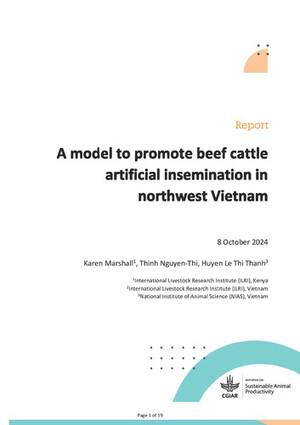
Estrus performance of boran and boran × holstein friesian crossbred cattle synchronized with a protocol based on estradiol benzoate or gonadotrophin-releasing hormone
Abstract
The objectives of this study were to determine estrus behavior, interval to estrus, duration of estrus and time of ovulation of Boran, and Boran × Holstein Friesian (HF) breeds. A total of 113 cows and heifers from the two breeds were synchronized with two estrus synchronization protocols: 1) estradiol benzoate (EB) + controlled internal drug release (CIDR) + prostaglandin (PGF2?); and 2) gonadotrophin (GnRH) + CIDR + PGF2?. The results (mean ± SE) showed that the Boran breed had significantly longer interval to estrus (70.67 ± 5.9 versus 54.58 ± 4 h), shorter duration of estrus (8.65 ± 0.83 versus 12.1 ± 0.7 h) and lower behavioral score (mean ± SD; 883 ± 639 versus 3,399 ± 957) compared to Boran × HF crossbred cattle. Animals treated with EB + CIDR + PGF2? had a significantly shorter interval to estrus (46.75 ± 4 versus 78.5 ± 4 h), higher behavioral score (3,058 ± 1,223 versus 2,663 ± 991) and longer duration of estrus (11.31 ± 0.71 versus 9.4 ± 0.75 h) compared to animals treated with GnRH + CIDR + PGF2?. The interval from estrus to ovulation (26 ± 2.5 h) was not different between breeds and between synchronization methods. The Boran (Bos indicus) breed tended to have a longer interval to estrus, shorter duration of estrus and an estrus behavior score lower than Boran × HF crossbred cattle treated and managed under similar conditions. The protocol using EB + CIDR + PGF2? was more effective than GnRH + CIDR + PGF2? in terms of enhancing estrus behavior and creating tight synchrony.
Citation
Tadesse, M., Thiengtham, J., Pinyopummin, A., Prasanpanich, S. and Tegegne, A. 2011. Estrus performance of boran and boran × holstein friesian crossbred cattle synchronized with a protocol based on estradiol benzoate or gonadotrophin-releasing hormone. Kasetsart Journal - Natural Science 45(2): 221 - 232









